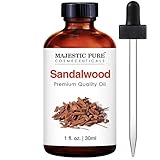The natural world around us is rich with trees and plants that produce essential oils beneficial to us. Sandalwood (Santalum album) is one such tree, cultivated for centuries to extract its valuable components for use in traditional medicine.
What benefits does sandalwood offer? Let’s explore them one by one and discover how to make the most of their properties:
Table of Contents
History of Sandalwood Oil (Santalum album)

Sandalwood oil, derived from the tree Santalum album, is renowned for its sweet, rich, and woody fragrance. This essential oil is highly prized in perfumery for its deep and lasting scent, which serves as a base note, enhancing and blending with other fragrance components.
Traditional and Cultural Significance: The use of sandalwood oil dates back over 4,000 years. In ancient times, sandalwood was transported across vast distances via caravans to regions such as Egypt, Greece, and Rome. It was revered not only for its aromatic qualities but also for its spiritual significance.
In many Asian cultures, particularly in India, Santalum album is considered a sacred tree. Sandalwood has been an integral part of religious rituals and ceremonies, symbolizing purity and spiritual enlightenment. Its use in temples and sacred spaces underscores its deep cultural and religious importance.
Western Popularity and Modern Use: In contemporary times, sandalwood oil has gained immense respect and popularity in the Western world due to its unique properties. Its distinct, woody aroma and therapeutic benefits have made it one of the most sought-after essential oils. As a result, it is now one of the most expensive essential oils on the market.
Quality and Extraction: The value of sandalwood oil is closely linked to the age of the tree from which it is extracted. For optimal quality, the oil is harvested from mature trees that are at least 40 years old. The older the tree, the more intense and refined the sandalwood oil extracted from its roots will be.
This aging process contributes to the oil’s depth of flavor and its esteemed position in both perfumery and traditional medicine.
The Sandalwood Tree
In its botanical classification, Santalum album is categorized as a tree. It can grow to over 4 meters tall over many years of development and is considered a long-lived plant, typically reaching an average age of 100 years.
A distinctive feature of this tree is its ability to parasitize the roots of other plant species. This allows it to obtain additional benefits without causing significant harm to the host plants.
This parasitic behavior is somewhat similar to that of certain fungi. The sandalwood tree uses modified roots to absorb nutrients from the roots of neighboring plants. However, unlike fungi, it only takes a small percentage of these nutrients and water, thereby minimizing the impact on the host plants.
Sandalwood is known for its use of wood and stems, which have a characteristic reddish color. When burned, it produces a well-known aroma that is attributed with medicinal properties.
Composition of Sandalwood Oil
Sandalwood essential oil is comprised of 80 to 90% sesquiterpene alcohols, with the majority consisting of two closely related molecules: alpha-santalol (50 to 60%) and beta-santalol (20 to 25%).
The primary chemical components of sandalwood oil are:
- Santalol
- Santalyl acetate
- Santalene
- 100% PURE & NATURAL SANDALWOOD OIL – Majestic Pure Blends oils are exactly that! Many oils being sold make that claim but are in fact made of natural isolates and mixtures. Each essential oil is tested by an independent lab which is why every bottle comes with a Quality Guaranty.
Medicinal Properties of Santalum album

Antiseptic
Santalum album possesses antiseptic properties that are effective against bacteria and fungi. It can be applied topically in the form of massage to reduce mild inflammation caused by bacterial agents in superficial wounds, warts, cysts, or pimples. In traditional Asian medicine, it has been used historically to combat urinary tract infections and to alleviate mucus in the throat and chest.
Improves Concentration and Aids Relaxation
The aroma of sandalwood oil (Santalum album) has calming effects on the nervous system, which helps alleviate stress and promote relaxation. It is a key ingredient in aromatherapy, which uses various aromatic compounds to influence the nervous system. Research published in the Journal of Complementary Therapies in Clinical Practice indicates that inhaling or absorbing sandalwood oil through the skin can enhance relaxation, aiding in better sleep without causing drowsiness.
Natural Aphrodisiac
Santalum album is often cited for its aphrodisiac properties. It can be used in massages or incorporated into gels and lotions to boost libido, particularly in men, and increase energy. Adding sandalwood oil to massage oils or topical lotions can enhance its aphrodisiac effects.
Strengthens Memory
By inducing a state of relaxation and calm, Santalum album can act as a memory booster. It is beneficial in aromatherapy before studying or when needing to focus on a task. Noticeable improvements in concentration can be experienced when using sandalwood oil.
Astringent
Sandalwood is a mild astringent, which can cause minor contractions in soft tissues and skin, such as on the arms, thighs, and feet. Many skincare products, including facial tonics, creams, and aftershaves, use sandalwood oil to soothe, cleanse, and tone the skin.
Anti-Inflammatory Activity
Santalum album also has anti-inflammatory properties, providing relief from mild inflammation caused by insect bites, contact irritations, and other skin issues. A 2014 study demonstrated that the active component, santalol, helps reduce inflammatory markers known as cytokines. Santalol may function similarly to non-steroidal anti-inflammatory drugs (NSAIDs) but without the adverse side effects.
Expectorant
Santalum album can be beneficial in treating dry coughs, similar to lavender or mint, while also providing relaxing effects. It helps prevent the growth of bacteria that could cause respiratory conditions. To use sandalwood oil for this purpose, add a few drops to a tissue and inhale for several minutes to soothe an irritating cough.
Hypotensive
Studies have examined Santalum album for its potential to lower blood pressure. A 2004 study found that sandalwood oil can have hypotensive effects, reducing systolic blood pressure compared to placebo controls.

Does Santalum album Oil Have Contraindications?
Generally, it is rare to experience irritations or topical inflammations after applying sandalwood oil. However, it is advisable to perform a patch test before full application. Apply a small amount of the oil to the inner forearm and wait several minutes. If there is no redness or itching, the oil can be used safely on the skin.
Caution is advised for individuals with severe kidney disease. Additionally, it is recommended not to use sandalwood oil for periods longer than 6 weeks.


